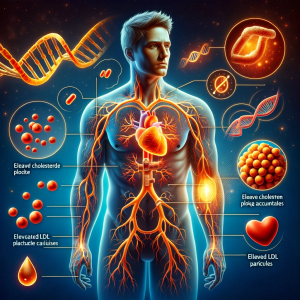 Abstract: This article provides a comprehensive overview of familial hypercholesterolemia (FH), a genetic disorder characterized by elevated low-density lipoprotein cholesterol (LDL-C) levels, predisposing individuals to premature cardiovascular disease. It delves into the genetic basis, pathophysiology, clinical manifestations, diagnostic criteria, and management strategies of FH.
Abstract: This article provides a comprehensive overview of familial hypercholesterolemia (FH), a genetic disorder characterized by elevated low-density lipoprotein cholesterol (LDL-C) levels, predisposing individuals to premature cardiovascular disease. It delves into the genetic basis, pathophysiology, clinical manifestations, diagnostic criteria, and management strategies of FH.
1. Introduction: Familial hypercholesterolemia is an autosomal dominant disorder, resulting from mutations affecting the metabolism and clearance of LDL-C. Its early diagnosis and management are crucial in preventing cardiovascular morbidity and mortality.
2. Genetic Basis: FH is most commonly caused by mutations in the LDL receptor gene, leading to reduced clearance of LDL-C from the bloodstream. Other genetic mutations implicated include those in the apolipoprotein B (APOB), proprotein convertase subtilisin/kexin type 9 (PCSK9), and LDL receptor adaptor protein 1 (LDLRAP1) genes.
3. Pathophysiology: The underlying defect in FH is the impaired hepatic uptake and catabolism of LDL-C, resulting in its elevated plasma levels. This hypercholesterolemia is a major risk factor for atherosclerotic cardiovascular disease (ASCVD), including coronary artery disease and cerebrovascular disease.
4. Clinical Manifestations: Patients with FH typically present with high LDL-C levels from an early age. Physical findings may include xanthomas (cholesterol deposits in tendons) and corneal arcus. A family history of premature ASCVD is common.
5. Diagnostic Criteria: Diagnosis is based on clinical criteria, including elevated LDL-C levels, family history, and physical findings, supplemented by genetic testing for definitive diagnosis.
6. Management Strategies:
- Lifestyle Modifications: Emphasis on a healthy diet, regular physical activity, and smoking cessation.
- Pharmacotherapy: Statins are the cornerstone of therapy, often in combination with other lipid-lowering agents like ezetimibe and PCSK9 inhibitors for optimal LDL-C reduction.
- Monitoring and Follow-up: Regular monitoring of lipid levels and cardiovascular risk assessment.
7. Genetic Counseling and Screening: Given its genetic nature, family screening and genetic counseling are integral components of managing FH, enabling early diagnosis and intervention in affected relatives.
8. Conclusion: Familial hypercholesterolemia is a critical public health concern, with significant implications for cardiovascular health. A multidisciplinary approach involving early detection, aggressive management, and family screening is key to mitigating its impact.







